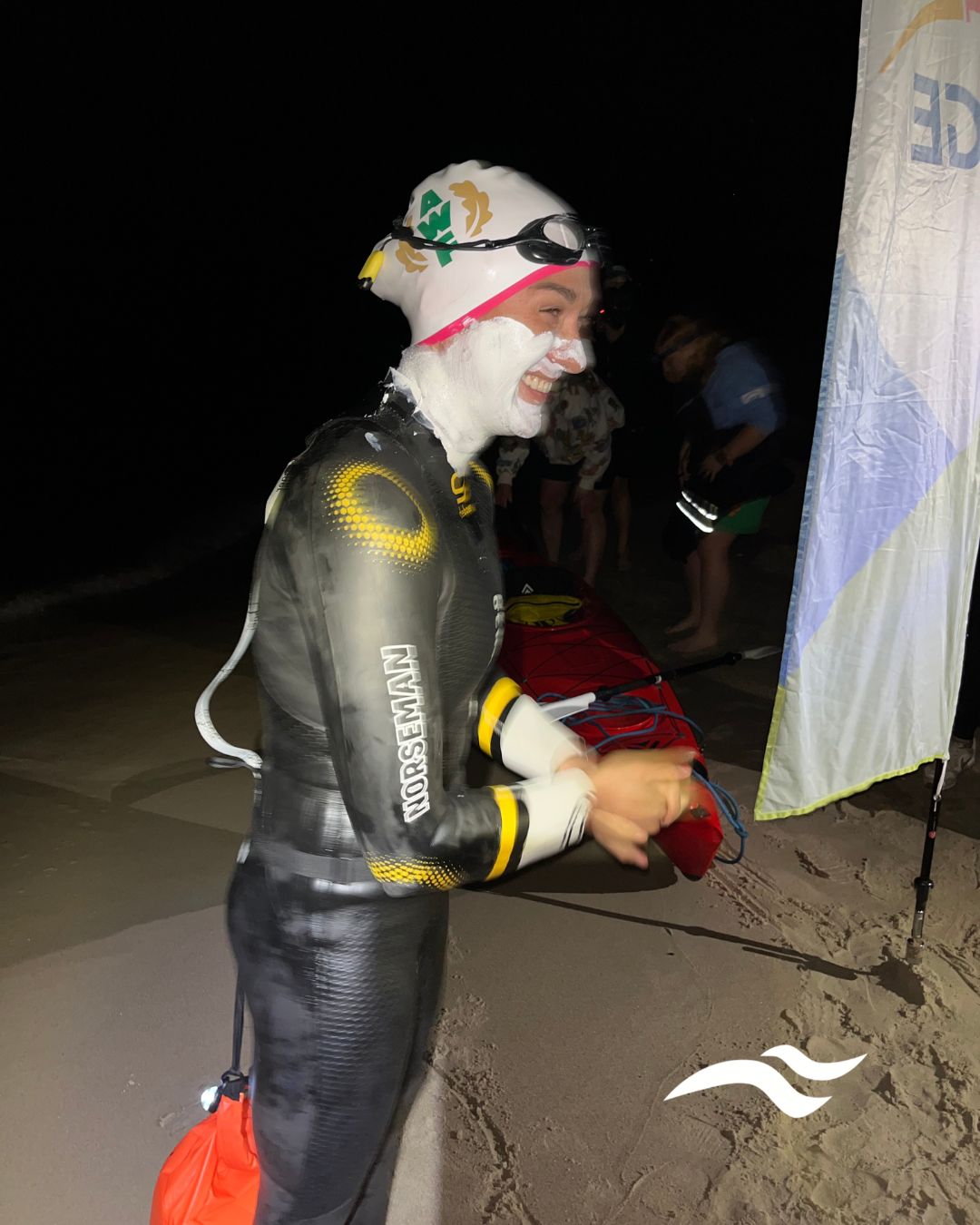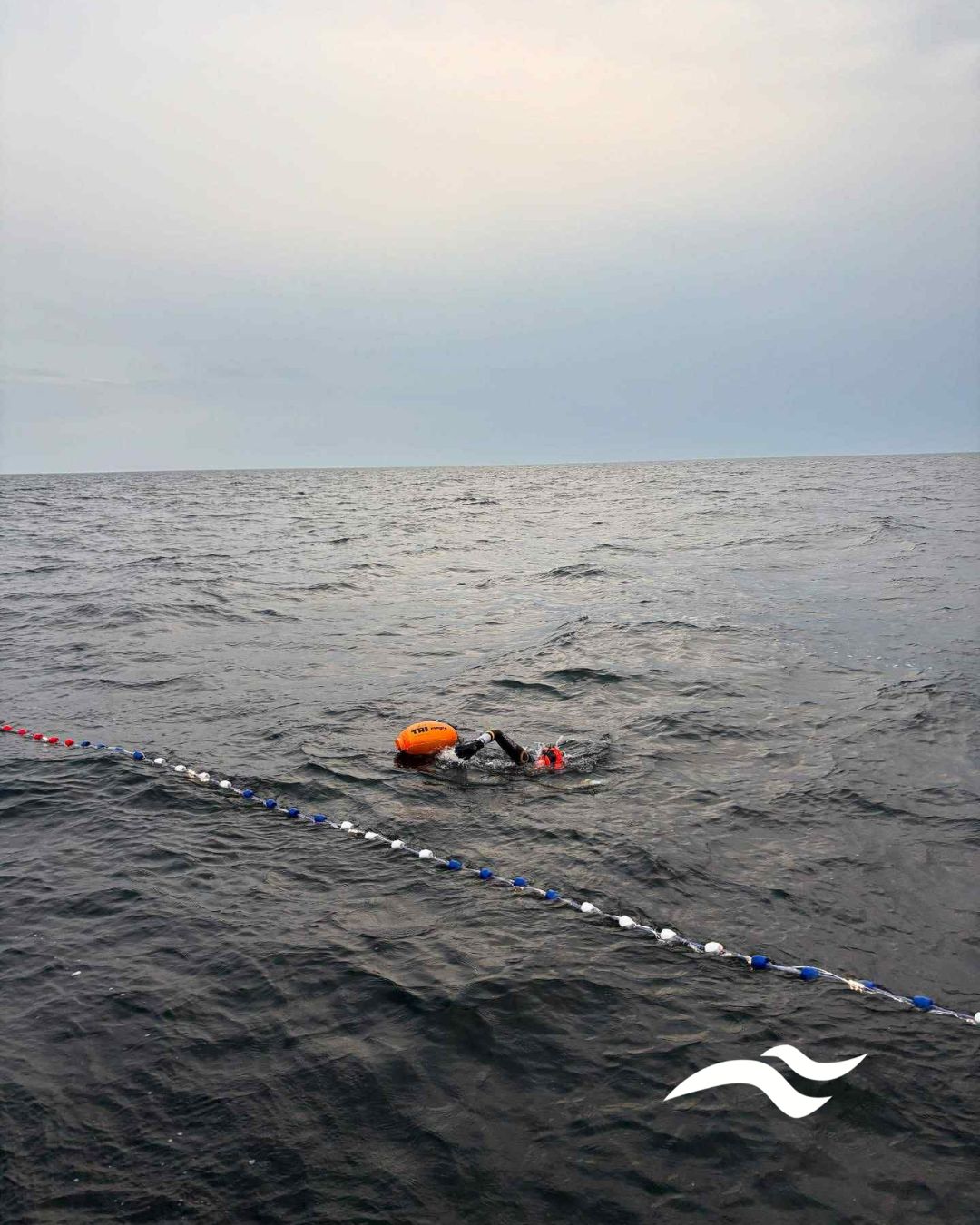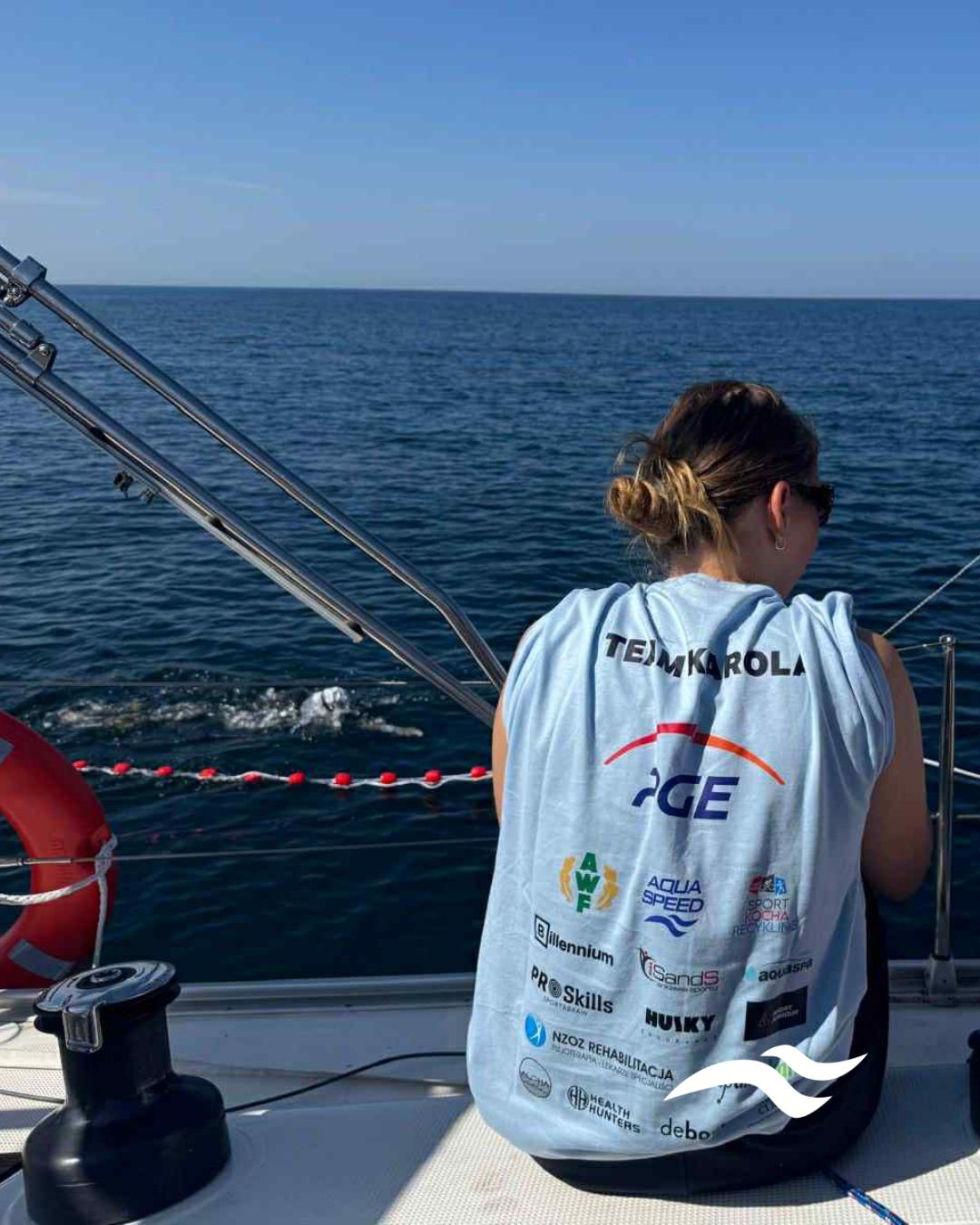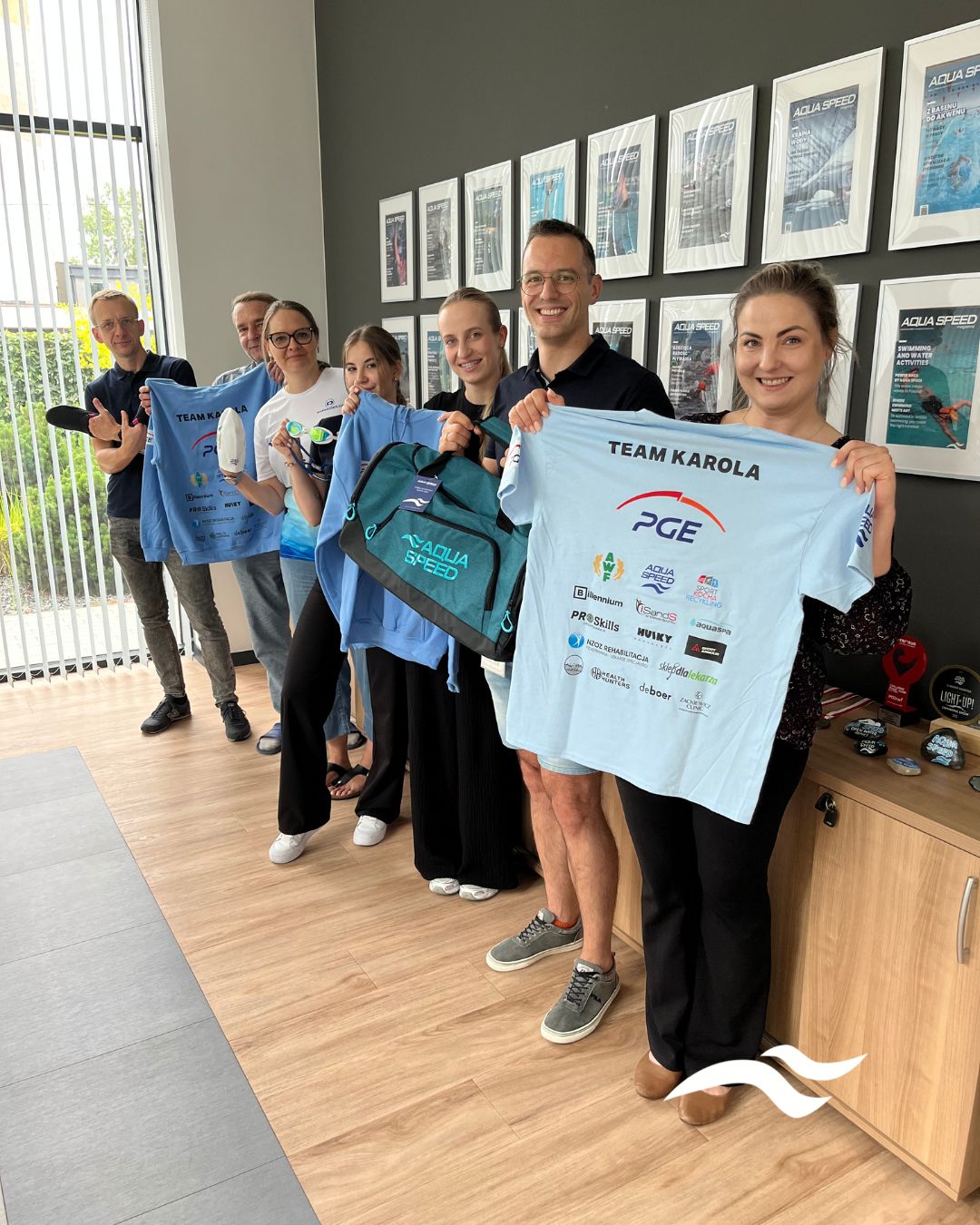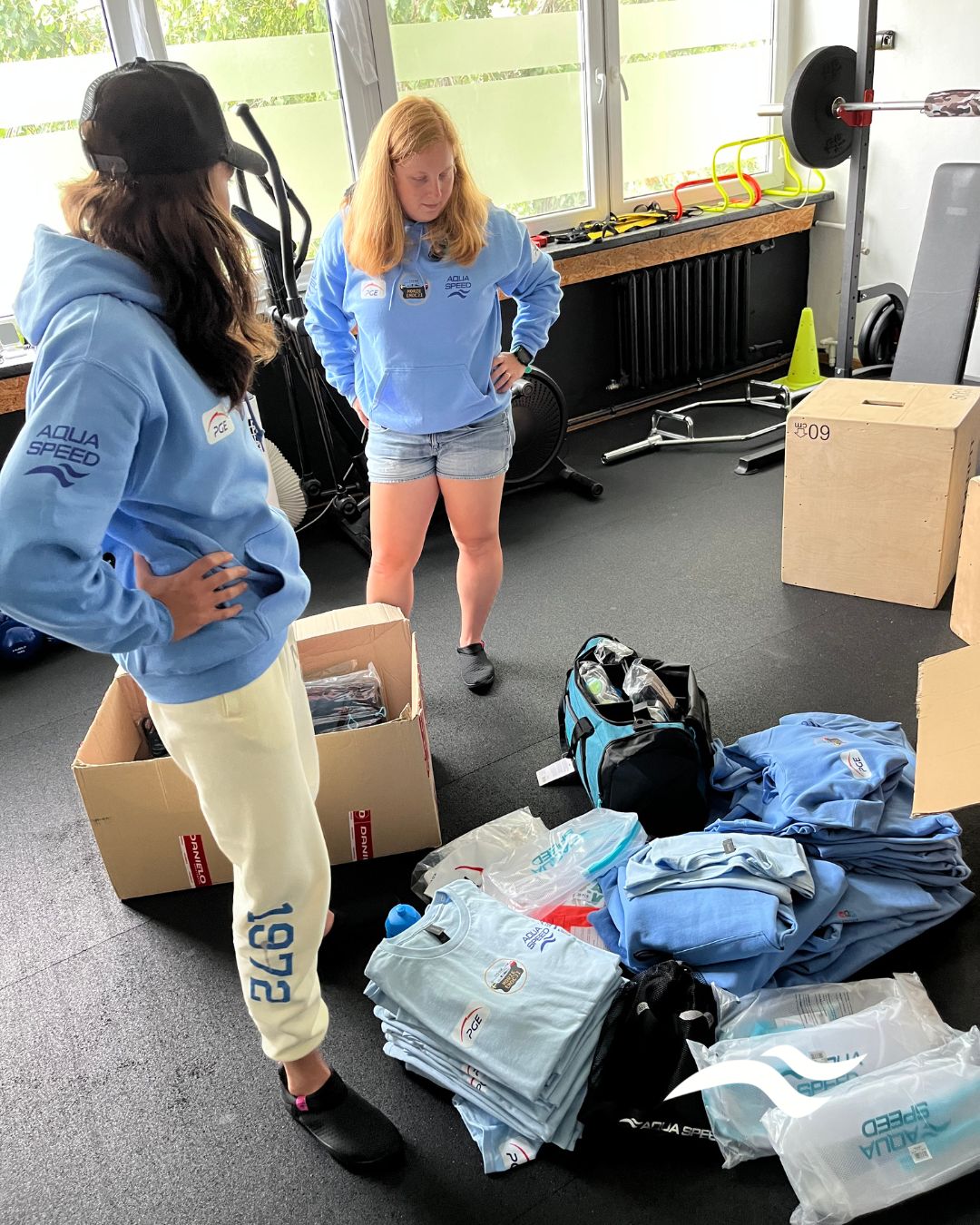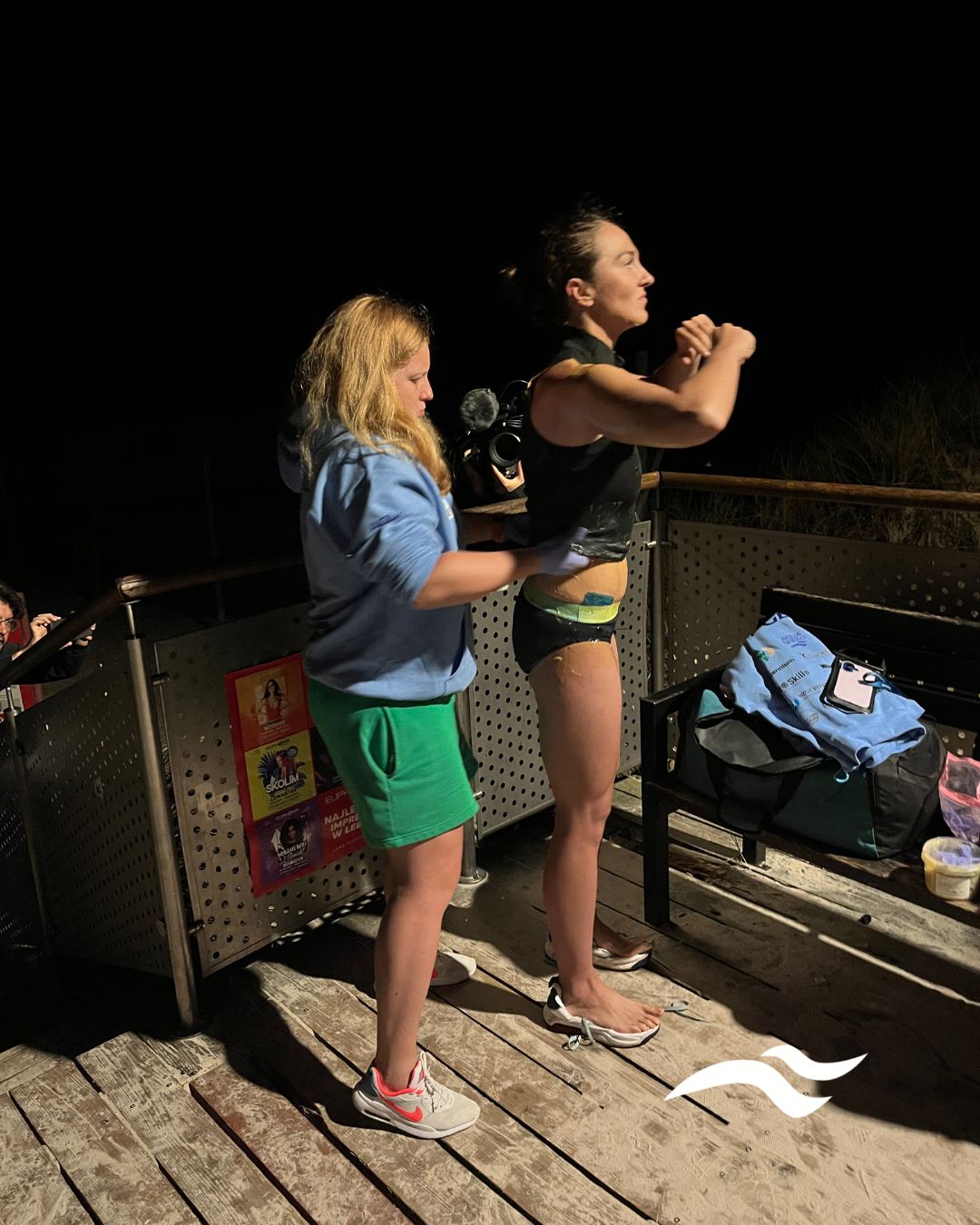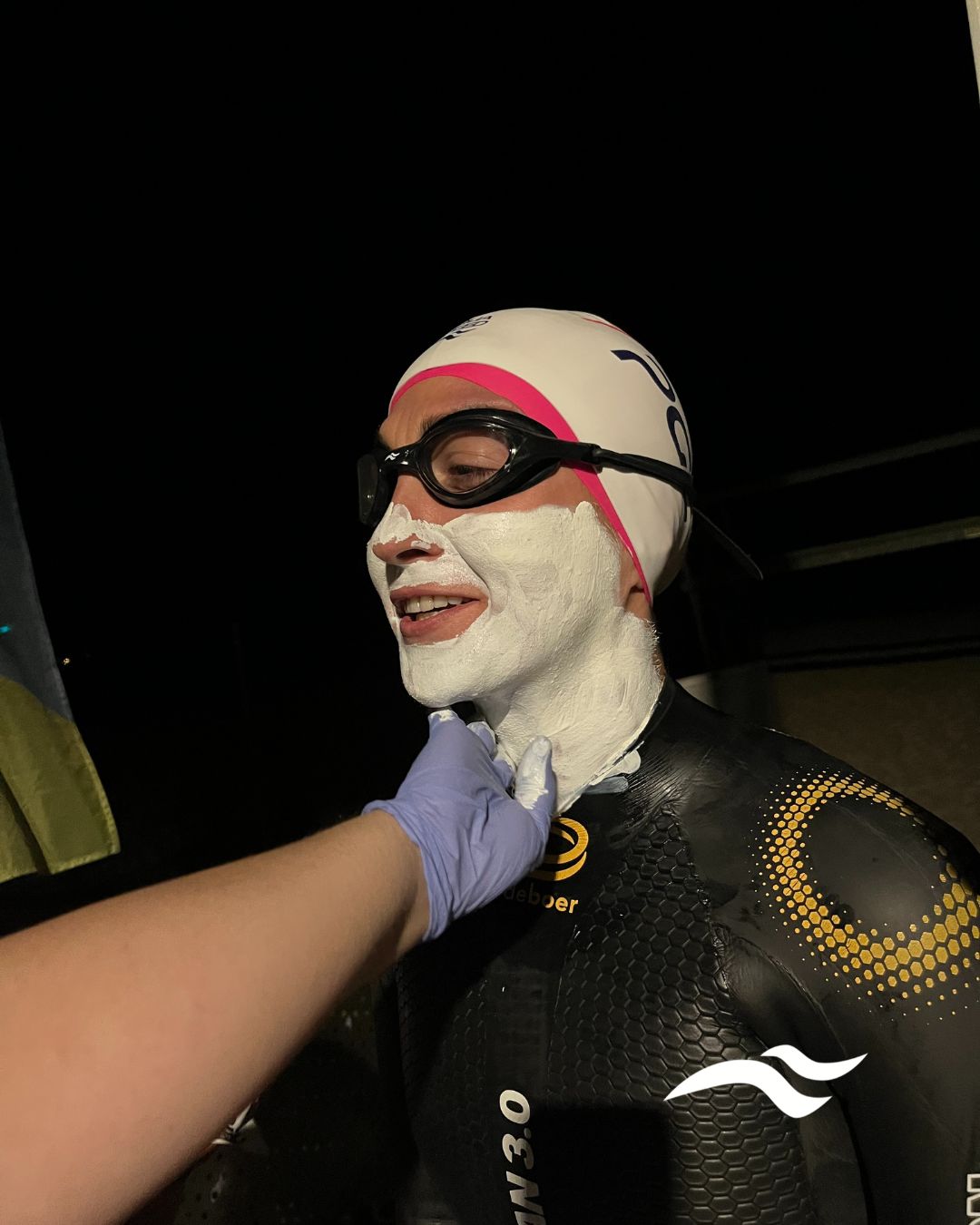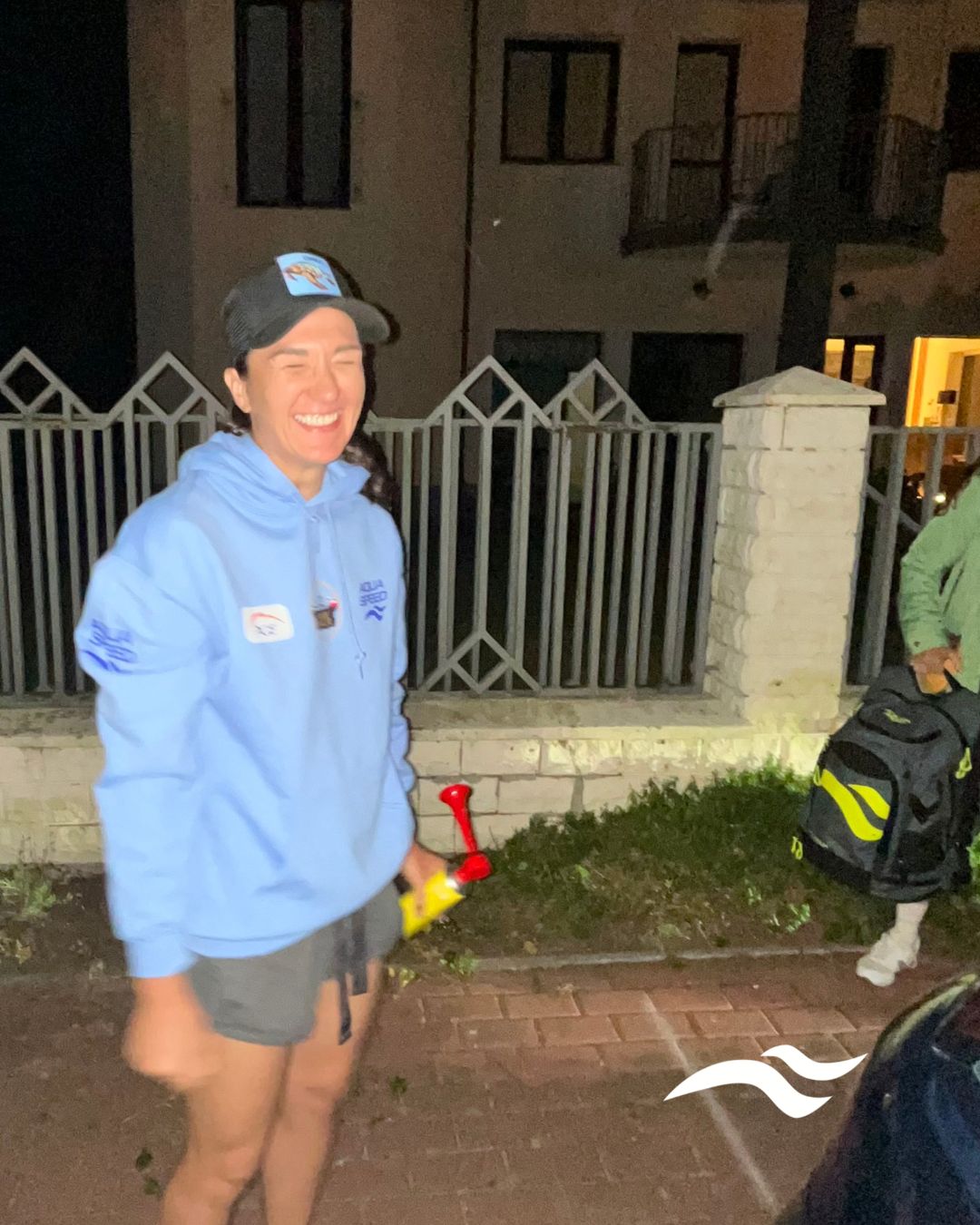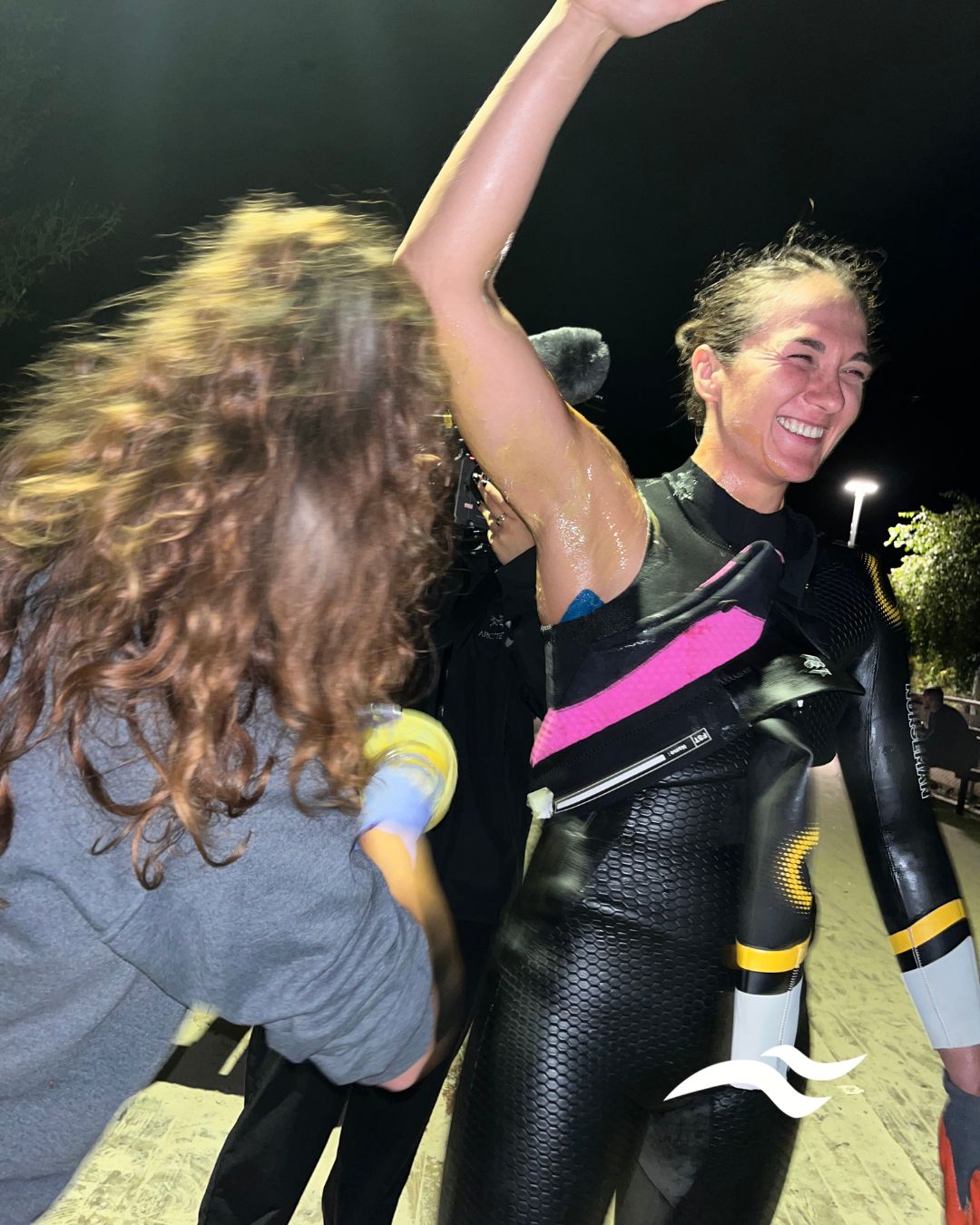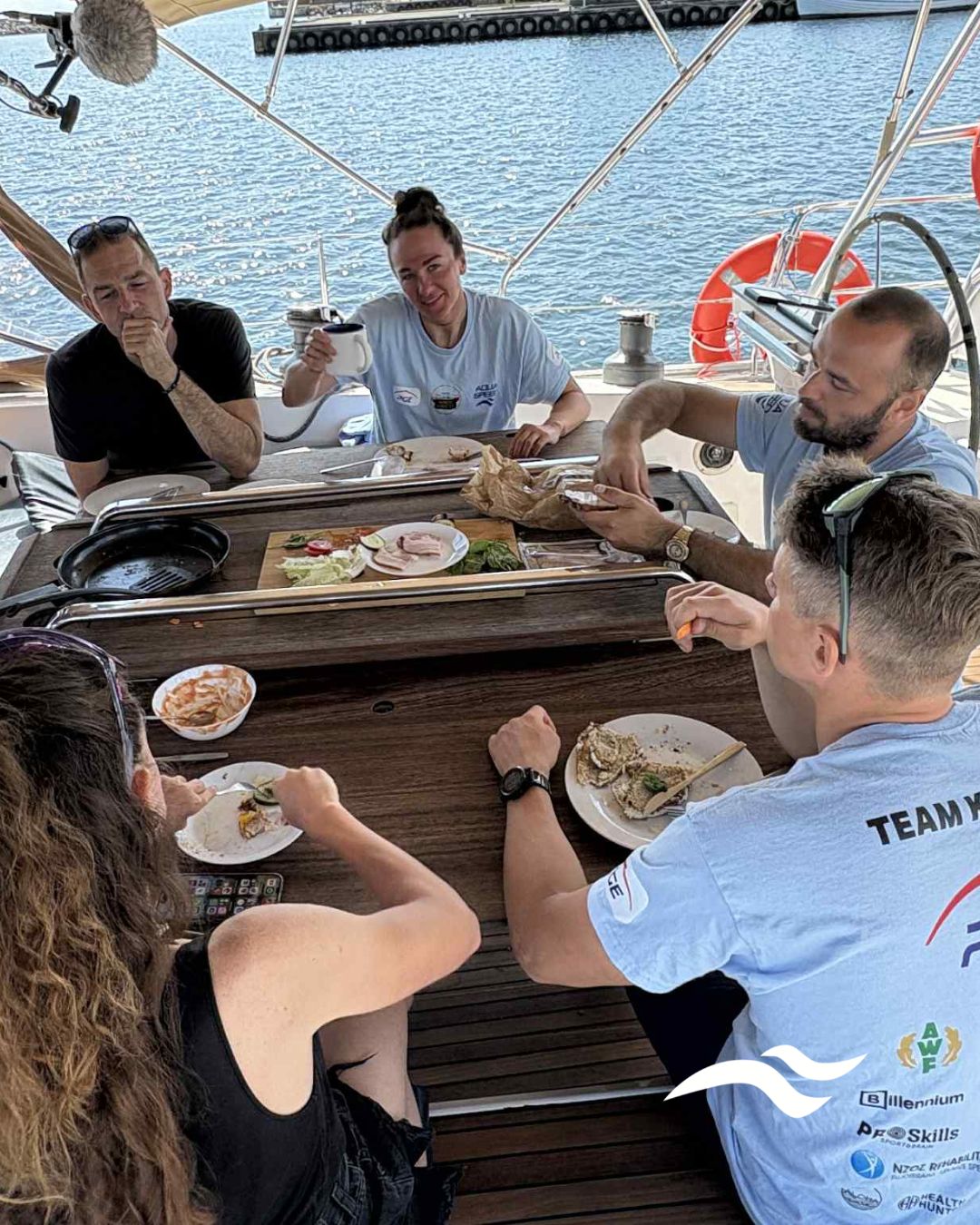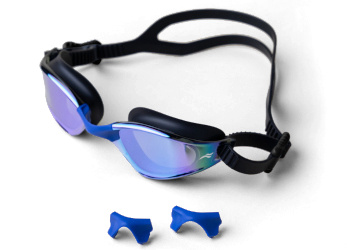Swimming is an adventure that begins during the first lessons, develops in the pool while refining technique and building endurance, and reaches its full expression in open water competitions. As the distance increases, so does the appetite for new challenges. This is how projects are born that push boundaries — not only geographical ones, but also the limits of the body, mind, emotions, and even social taboos.
Karolina Szczepaniak has now embarked — in a very serious way — on the adventure of a lifetime in ultra open water: the first female attempt to swim across the Baltic Sea.
She was prepared thanks to solid physical and mental training, motivated after setting the Guinness World Record for the longest distance swum in 48 hours, and supported by an excellent team — in which we, the AQUA SPEED Team, also played an important role.
We accompanied Karolina during several months of preparations and were with her just before her nighttime start in Łeba. The AQUA SPEED Magazine editor stayed awake throughout the night to capture the most exciting moments from the start. Read our interview with Karolina and with Paulina Batorzyńska from Karolina’s team, who spoke to us right after the completion of the first attempt to swim across the Baltic Sea.
The body after 50 hours and 140 kilometers in the water
Karolina, you look surprisingly good after this achievement… You swam over 140 km in more than 50 hours! Aren’t you worried that someone might think: “If this girl looks fine after a week, then I can do it without any problem”?
Karolina Szczepaniak: After being taken out of the water, I knew what was happening. Although I was slightly delayed, mainly due to mild hypothermia, I was in very good mental condition. As for my physical state, unfortunately, it was very difficult right after leaving the water. I couldn’t stand on my own; my legs remained stiff for another six hours. Every tiny movement was impossible, because it came with severe pain in my hips and legs. This condition persisted as long as my hips and legs refused to release their stiffness.
After six hours, when the pain subsided and I was finally able to move one leg away from the other, I could also go to the bathroom — of course with the assistance of the people supporting me, because I still struggled to stand upright. A few hours later, I was already eating dinner at a nearby bar on the marina in Sweden, where my support team had stopped.
I was able to reach this state thanks to 17 years of a professional swimming career, thousands of kilometers in the water, and 17 months of very meticulous preparation for this challenge. If someone is carefree and thinks they’re stronger than others, then they can always try… [laughs]
Some people who feel like real-life superheroes are simply resistant to knowledge and often sign up for Ironman races, marathons, or other ultra events after just a month of “training.” Of course, the body can endure a lot, so completing those races is possible. But over time, various injuries appear — and they often end up blaming others, because admitting one’s own mistakes is too difficult psychologically. That’s just how it is… [laughs]
I believe anything can be accomplished — but only if it is preceded by solid, thoughtful, and genuine preparation. Today we live in a world where everyone wants to achieve things quickly. Unfortunately, in sports, just like in business, time and patience, consistency and discipline are essential. There will always be people who want to take shortcuts.
How do you endure more than 50 hours in the water?
You entered the water and… turned off your mind for more than 50 hours? What has to happen in your head to stay conscious and focused, yet not fully feel what hurts?
KS: During this challenge, you can’t shut yourself off from the pain, because the body sends signals about what’s happening inside. Turning off pain receptors during something like this could end very badly. The ability to accept and tolerate pain is something different from disconnecting from it. I swam for more than 30 hours with unimaginable hip pain, cramps in both thighs, and an increasingly sore lumbar section. Along with that pain, I entered deep meditative states.
I am extremely satisfied with what I managed to achieve in the field of sports psychology. It makes me even more convinced that the ability to manage internal processes is key to accomplishing ultra-endurance efforts. You need to reach a high level of inner harmony, which — as we know — is discovered step by step. Awareness of your inner world gives you enormous possibilities, but it also requires openness and accepting things about yourself that are not pleasant. Not everyone is ready for that, and that’s perfectly okay too.
The role of the support team in ultra open water
What role does the support team play in such a project — is it a form of external steering? Do the people on the boat see and know when things are going well or badly, what to give you to eat, etc.? Who decides whether you continue swimming, and who decides when you are taken out of the water?
KS: My support team consists of 10 people I can rely on, who know me to varying degrees depending on their responsibilities. They were all informed about what to do, what to say, and what not to say — and they followed these rules meticulously, regardless of my attempts to get information we had agreed was not to be shared. This only proves how committed they were to their tasks.
I’m incredibly proud of them.
The food had been tested by me beforehand during both day and night training sessions. According to those preparations, that’s exactly what I was given. Sometimes they asked what I would like — and those moments were also necessary, because they brought some variety into the overwhelming monotony.
Three people were responsible for making the decision about ending the swim. A majority vote determined whether I would be taken out of the water or allowed to continue.
At the moment I was taken out of the water, all three people were in full agreement about the decision.
AQUA SPEED equipment during the Baltic crossing
AQUA SPEED provided you with equipment. The team received bags, dry bags, shoes, etc. You had Vortex Mirror and Vortex Vision goggles at your disposal. How did all of this perform in such an extreme situation?
Paulina Batorzyńska: AQUA SPEED equipped us with gear that really made our work much easier.
We had training bags with special compartments that separated items inside the bag, so everything was organized and nothing had to be searched for — a very convenient solution for the support team! We will definitely use them again during future sporting events.
Then there were the shoes — comfortable, quick-drying, non-slip, and safe. We moved around the boat without any problems. With so many hours of work, foot comfort is essential.
The bottles helped us stay consistently hydrated and kept things tidy. The support team remembered to drink regularly because the bottles were simply handy and convenient.
The plastic pouches — usually meant for storing wet, post-training clothes — were used to pass food to Karolina. They were waterproof, lightweight, and very durable. We tied them to a rope and tossed them into the water with the food inside. They went through a lot, but still look like new.
The swim cap that Karolina selected very precisely served reliably throughout the entire crossing.
And of course the goggles — Vortex Mirror and Vortex Vision. Karola absolutely loved them! Two types: one for the day — mirrored, and one for the night — clear — worked perfectly. Throughout the entire crossing, she only switched models depending on the sunlight. The goggles fit well, seal comfortably around the eye sockets, and don’t leave marks or “goggle imprints,” which makes swimming far more comfortable. A big advantage is having two versions: mirrored and clear. Many people don’t realize that it’s worth switching goggles depending on the time of day and lighting conditions, because it reduces eye strain. Clear goggles at night improve visibility, and during the day, when it’s bright and sunny, the mirrored ones work better. In open-water and ultra swimming, this significantly reduces the workload on the eyes. Of course, such changes can also be beneficial in pool swimming when the lighting is very bright or dim, or during night competitions, when cognitive functions weaken and vision deteriorates.
As for Karola — and I’m not talking only about the crossing itself, but especially the preparation and training — she also used soft, comfortable flip-flops that fit well, don’t slip on wet pool surfaces, and, of course, look great.
Regarding the towels, they absorb water well and don’t take up much space in a backpack or bag.
The poncho worked perfectly after pool training, open-water sessions, and even winter cold-water swims. And the best part — it comes in Karolina’s favorite color: purple [smiles].
I can confidently say that Aqua Speed equipped us from head to toe — literally. Both us, the support team, and Karolina herself — and we are very satisfied and proud of that.
---
>>> The equipment Karolina used is listed at the end of the article. <<<
Comfort in ultra-distance swimming
What elements made up your swimming outfit? How did you protect yourself to maintain some level of comfort while swimming? Does comfort need to be maximized in order to endure such an effort?
KS: Comfort is extremely important, because I had to wear equipment that stayed on me continuously for more than 55 hours. After various trials, we reached the conclusion that my entire body would be covered with a very thick layer of lanolin. My face was coated with Desitin cream. I wore the bottoms of a two-piece sports swimsuit. On my chest, I put on a thermal vest from DeBoer and a Norseman neoprene wetsuit from the same company. On my head, I wore two swim caps from Aqua Speed and Vortex Mirror or Vortex Vision goggles — depending on the intensity of sunlight. During the challenge, I also put on DeBoer neoprene socks and a thin neoprene cap, and at the very end of the challenge — neoprene gloves.
Nutrition and diet for an ultra-distance swimmer
More than 50 hours in the water. What did you eat and drink? Over 50 hours in a wetsuit… how do you go “number one” and “number two” while swimming? Or is the diet designed so that this problem doesn’t occur?
Physiological needs are the most frequently asked question. Maybe people just want to hear that a woman “does it in her armor” [laughs]. Nothing like that! To maintain dignity, I took medication beforehand, provided by a medical professional. It prevented the possibility of needing to defecate during the challenge. After the attempt ended, I was able to use the bathroom without any problems — no constipation or other issues.
I ate mostly liquid, semi-liquid, or solid foods selected in consultation with dietitian Aleksandra Barwińska. Of course, every meal was tested by me during training. We didn’t rely on foods I like, because those often caused indigestion — and with a heavy heart, we removed them from the potential menu. I drank mainly tailored supplements from Husky or Sport Armour, depending on my needs. All of this was also tested during training.
Another attempt to swim across the Baltic already in 2026
Very soon after finishing the crossing you said that you plan to try again next year. Was that an impulse or a well-thought-out decision? Do you already know what needs to be improved, changed, or refined?
I must have said about sixteen times during the challenge that I would never enter the Baltic again; that I wouldn’t even come here for vacation, because this challenge is truly horrendously difficult for both the body and the mind.
Nevertheless, the condition I was in afterward allows me to believe that I have a huge potential and an extraordinary capacity to endure unimaginable physical strain under sleep deprivation.
My preparations were unique — very difficult, yet meticulously detailed. I am aware that the fact this was our first attempt meant that there were some things we simply could not anticipate. I believe that if those aspects are improved, next year could truly end with a historic crossing of this beloved body of water. [smiles]
Development of Karolina Szczepaniak’s swimming career and swimming school
What happens in the meantime? The past year was intense: you broke a Guinness World Record in the pool, and now another year of preparation and maintaining public interest lies ahead. Do you feel pressure? Do you consider this a challenge? How do you handle potential pressure — both as an athlete and as an entrepreneur?
This year will be special for me, because I am opening my own swimming school — PRO SKILLS SWIM SCHOOL — where I want to inspire people with a passion for water, expanding their mental horizons, and building relationships based on trust and shared interests.
Of course, I remain a sports psychologist and will continue working with athletes who know what they want from life and from themselves. In addition, my training process will certainly provide plenty of emotions for everyone who follows me on social media and beyond.
I’m preparing something really big. [smiles] My training will change a bit. I will definitely continue working with Paulina Batorzyńska on motor skills, joint strengthening, and increasing range of motion. I believe she is one of the few people on the market who approaches every person with such precision and has her own training space — which is important so nothing distracts you during preparation. My coach, Will Leonhart, has extensive knowledge and a unique approach to ultra distances. Thanks to him, I don’t feel “burnt out” and I remain motivated to keep training.
My physiotherapist, Krzysztof Nowogrodzki, will continue putting me back on my feet after the tougher training sessions. And of course, I will keep working with dietitian Aleksandra Zackiewicz. I want to work with her because it’s been a long time since anyone impressed me so much with their knowledge and flexibility in selecting mineral components. I must emphasize that there are no ultra-specialized dietitians on the market, and sports dietitians often don’t want to take on this type of cooperation for various reasons.
I have a lot of work ahead of me, but I feel calm when I think about it. Everything requires time and consistency. I want to surround myself with people who truly wish me well. Many relationships were tested along this journey — that’s just life. I want to live in reality, not in an illusion of it.
---
Interview by: Maciej Mazerant / Managing Editor, AQUA SPEED Magazine
Photos: AQUA SPEED and Karolina’s Team


